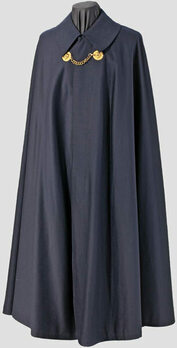Kriegsmarine Cape
SKU: 21.GOR.02.01.04.001
Estimated market value:

Estimated market value:
Attributes
History
The headgear, uniforms, and insignia worn by members of the Kriegsmarine were based upon the designs utilized by the Kaiserliche Marine (Imperial Navy) and the Reichsmarine (Navy of the Weimar Republic). The official regulations governing the uniforms of the Reichsmarine were issued on April 5, 1921, and they were embraced, with a few alterations, as the Kriegsmarine uniforms in 1935.
From 1933 to 1945, the uniforms worn by personnel in the German Navy were produced and disseminated by the Navy Clothing Depot and private manufacturers. The cloth was of a high quality prior to the Second World War, but during the war, it became increasingly synthetic and of lower quality. Similarly, the cloth used in the uniforms of Officers and Admirals was of a higher quality than the cloth used in the uniforms of lower ranking personnel, such as Non-Commissioned Officers and Enlisted Men. The cloth utilized in garments of the blue uniform is of an overall better quality than the cloth utilized in the field-grey uniform. For the field-grey uniform specifically, the cloth is more grey-coloured in pre-war uniforms, while the cloth is more green/olive-coloured in wartime uniforms.
The main colour of Kriegsmarine uniform pieces is a dark navy blue. However, during the summer months, and initially also in regions with warmer climate, a white summer uniform was used. Eventually, a brown tropical uniform was introduced for units stationed in tropical and subtropical regions. Land-based Kriegsmarine units, most of which were part of the Coastal Artillery, wore Army-like field-grey uniforms in the style of the Kriegsmarine.
The garments may have proof stamps, serial and unit stamps, and manufacturer marks denoting the legitimacy and origin of the item. They also tend to feature sewn name tabs (Namensläppchen) on all clothing items associated with the blue and field-grey uniforms. The blue uniform garments all have a serial number stamp (Stammrollennummernstempel), while the field-grey uniform garments have a unit stamp.
The proof stamp is present on all garments produced by the Navy Clothing Depot, and it includes the size of the item, if needed, with the year of manufacture above the size, and a surmounting script that reads “B.A.K.” or “B.A.W.”. This stamp information is framed, and written in white ink on blue or black garments and in black ink on all other colour garments.
The serial stamp is composed of letters and numbers, and it is present on blue uniform garments from the Depot. The stamp is either printed in red ink or sewn in red thread. The numbers are preceded by a letter that denotes the area in which the wearer served, with an “N” for Navy Station or an “O” for Navy Station Baltic. The stamp ends in a letter associated with the wearer’s career group, with an “S” for deck personnel and a “T” for technical professionals. Below the serial number is the year in which the wearer entered the navy, surmounted by a horizontal line.
The unit stamp is present on field-grey uniforms. It includes the framed, shortened unit name of the wearer in red ink.
The marks of private manufacturers vary widely, ranging from codes to full names, and even abbreviated letters, as well as the year of manufacture. After 1942, Reich numbers (Reichsbetriebsnummern) were also used as manufacturer marks (RB-).
The buttons worn on Kriegsmarine garments are generally gold-coloured, except for the uniforms of Officials which used silver-coloured buttons. The buttons feature the image of a fouled anchor on the obverse. The buttons are composed of brass, or of light metal. The gold-coloured buttons were gilded, while the silver-coloured buttons were silvered. As well, in the case of special uniform garments the buttons may be composed of plastic.
The Kriegsmarine Cape was worn by Officers, and Officials of equivalent rank when the standard blue and field-grey uniforms were not required for formation. These capes were worn as part of the evening dress, as well as part of the casual street dress. The cape length extended to the mid-calves line of the wearer.
The cape is constructed from two main fabric panels that are joined down the back with a central seam. It is primarily composed of fine quality cloth, such as doeskin or worsted wool, but there are also rare examples of the cape which are made from waterproof wool. The blue uniform capes were made with navy blue coloured cloth, while the field-grey capes were made with field-grey coloured cloth or less fine wool cloth (Lodenstoff).
The cape collar is made of badge cloth, and it features an additional stiffener in the collar lining.
This cape also features variation in the extent and type of lining. The lining may be found throughout the entire body of the cape, or it may be restricted to the shoulder sections. The fabric used for the lining varied depending on the use of the cape. If the cape was used for evening wear the lining tends to be composed of light grey, artificial silk, whereas if the cape was used for casual street wear the lining tends to be composed of light grey, thin, wool or wool-like cloth. The design of this cape did not officially feature pockets, they were sometimes added to the lining immediately below the waistline or on the inside of the breast panels.
For the blue uniform capes, there is a cape fastener (Spanierschloss) directly below the collar; it is not featured on the field-grey capes. The fasteners feature two circular disks with the image of a lion, and the disks are joined by a chain. The disks and chain are gold-coloured (gilt) on the Officer capes and silver-coloured (silvered) on the Officials with the rank of Officer capes. The front of the cape is also adorned with four buttons which are similarly gold-coloured (gilt) for Officers and silver-coloured (silvered) for Officials.
For the field-grey uniform capes worn by Officers, an additional hood could be attached to the collar via a series of small buttons along the interior and exterior of the collar.
These capes were only permitted for purchase until early 1940.
The cape is also known as “der Spanier”, the Spaniard.

Versions
$400 USD


Comments
Sign in to comment and reply.


Scroll Top